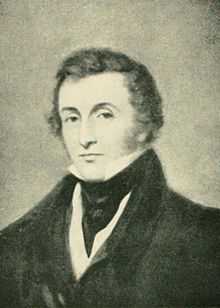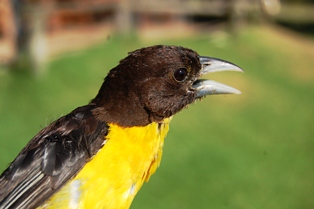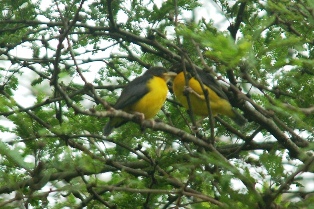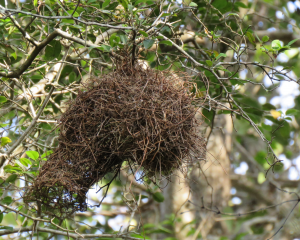Weaver species list / RELATED SPECIES: Bar-winged Weaver / Brown-capped Weaver / Dark-backed Weaver / Golden-naped Weaver / Maxwell’s Black Weaver / Olive-headed Weaver / Preuss’s Weaver / Red-bellied Malimbe / Red-headed Malimbe / Red-headed Weaver / Usambara Weaver / Yellow-capped Weaver / Yellow-legged Weaver / Yellow-mantled Weaver
IUCN: Least concern Discovery: 027
Categories: long tube, fruit, gum, nectar, Nest use, palm
Discovery


IntroductionThe Dark-backed Weaver was formally described by Louis Jean Pierre Vieillot, a French ornithologist. Vieillot already described it under a different name in 1818, but the name was not valid, and at first he thought it came from America. In 1819 he gave the valid name and noted that the specimen came from Senegal, but the Dark-backed Weaver does not occur west of Cameroon as was thought by early authors. Shelley 1887 first realised that the actual type specimen in Paris fitted birds from eastern South Africa, and later this was further restricted to the Eastern Cape.The Dark-backed Weaver was first collected by Francois Le Vaillant, who travelled in South Africa in 1781-84, and reached the Eastern Cape in 1782, where the Dark-backed Weaver occurs. When Le Vaillant returned to Europe, most of his specimens where sold or given to Coenraad Jacob Temminck, who had sponsored Le Vaillant’s travels. Temminck produced a catalogue of these birds in 1807 and briefly described the Dark-backed Weaver, without providing a scientific name, but calling it “Le verdier a ventre jaune” (Greenfinch with a yellow belly). He noted that it came from “Africa, Cape of Good Hope” (which includes the Eastern Cape). Vieillot based many of his descriptions on the work of Temminck 1807, but included a scientific name. Later Jacques Pucheran (1854), a French zoologist, noted that the Dark-backed Weaver type had been in the collection of Louis Dufresne, a French ornithologist and taxidermist at the natural history museum in Paris. Either the type had been transferred or Le Vaillant had more than 1 specimen, and kept one for the Paris museum, since Le Vaillant was friends with Dufresne. The collection of Louis Dufresne was sold to the University of Edinburgh in 1819 (and later moved to the Royal Scottish Museum). The first illustration of this species to be published, was by William Jardine in 1836, a Scottish naturalist, who had access to the Scottish collection. In addition to the Dufresne specimen (Jardine did not know the apparent source as Dufresne), Jardine also had other specimens from Dr Andrew Smith.
 William Jardine, figure from wikipedia Scientific citationPloceus bicolor Vieillot 1819 Nouv. Dict. Hist. Nat., nouv. ed., 34:127 Senegal, errore = S Africa, vide Hartert 1907a. Restricted to Zuurberg, Addo, E Cape by Roberts 1931. Meaning of namesbicolor Latin: bicoloured, two coloured (bi-, twice, double; color, colour). First English nameYellow-bodied Loret (Jardine 1836). Alternate namesBlack-backed Weaver, Forest Weaver, Grey-backed Weaver, Hinge Bird, Solitary Weaver-bird, Spot-headed Weaver. CollectorLe Vaillant. Date collected1782, when Le Vaillant was in the Eastern Cape. Locality collectedEastern Cape, around Zuurberg. Type specimensType specimen may be in the Royal Scottish Museum.
|
The above is based on Weaver Wednesday 2, a weekly series about the discovery of each weaver species.
This species text first appeared as Weaver Wednesday [144] – Discovery [27]: Dark-backed Weaver on 2015-03-18
1. Basic biology
  Identification. The Dark-backed Weaver Ploceus bicolor is bright yellow below and dark above, the throat is solid black or mottled black and yellow. The sexes are alike (photo above). Juveniles (photo above) are duller than adults, have a mottled throat, and pale bill. The wing edges are dark (unlike Clarke’s Weaver). Distribution. Seven subspecies of the Dark-backed Weaver are recognised, although many more have been proposed (see map above, based on Birds of Africa): Habitat. The Dark-backed Weaver inhabits forested areas, including riverine and gallery forests in open country, and second-growth forest regenerating after shifting cultivation, coffee forests, denser patches in dry baobab woodland, and in South Africa dry Valley Bushveld. It joins mixed-species flocks of insectivorous birds. Food. Food items are mostly arthropods, including grasshoppers, beetles, caterpillars, bugs, flies and spiders. Other food items are berries, fruit, and nectar. This species forages in the tree canopy and at the leafy ends of branches.  Breeding. The Dark-backed Weaver is a monogamous, solitary nester, with the pair-bond lasting for several years. The nest is retort-shaped. The entrance is extended into a spout that is usually <30cm long but may be up to 60 cm. The nest looks rough because it is made of stiff materials such as thin vines and creepers. A pair usually nests in the same area each year, so there may be 2-3 nests close together. One nest took 7 days to complete, and another took 9 days. Although nests are often high, and at the end of twigs, snakes do reach them and take young. 
Other. The longevity record for Dark-backed Weaver is over 5 years in the wild, but can be expected to be much more (see news item). The song of the Dark-backed Weaver is often a duet, with the male and female singing the same elements in a nearly simultaneous sequence, after some introductory notes which show increasing synchrony. There are local dialects in this song which appear to remain stable over many years. There are large-scale differences in song between geographically separated populations. The young apparently learn the song from their parents and other adults, and the song type stabilizes within the first two years. |
The above is based on Weaver Wednesday, a weekly series about weaver species.
This species text first appeared as Weaver Wednesday [35]: Dark-backed Weaver on 2013-02-13
2. Breeding facts
| Pair bond Monogamous, pair-bond lasting for several years Breeding season Nest site Nest building Colony size Clutch size Egg colour Egg size Incubation Chicks and nestling period |
Breeding information based on Handbook of the Birds of the World, Vol. 15.
3. Photos of Weaver Nests
 Vm 29295 |
 Vm 28964 |
 Vm 28947 |
 Vm 28556 |
 Vm 28063 |
 Vm 27312 |
Thumb-nails of recent PHOWN records
